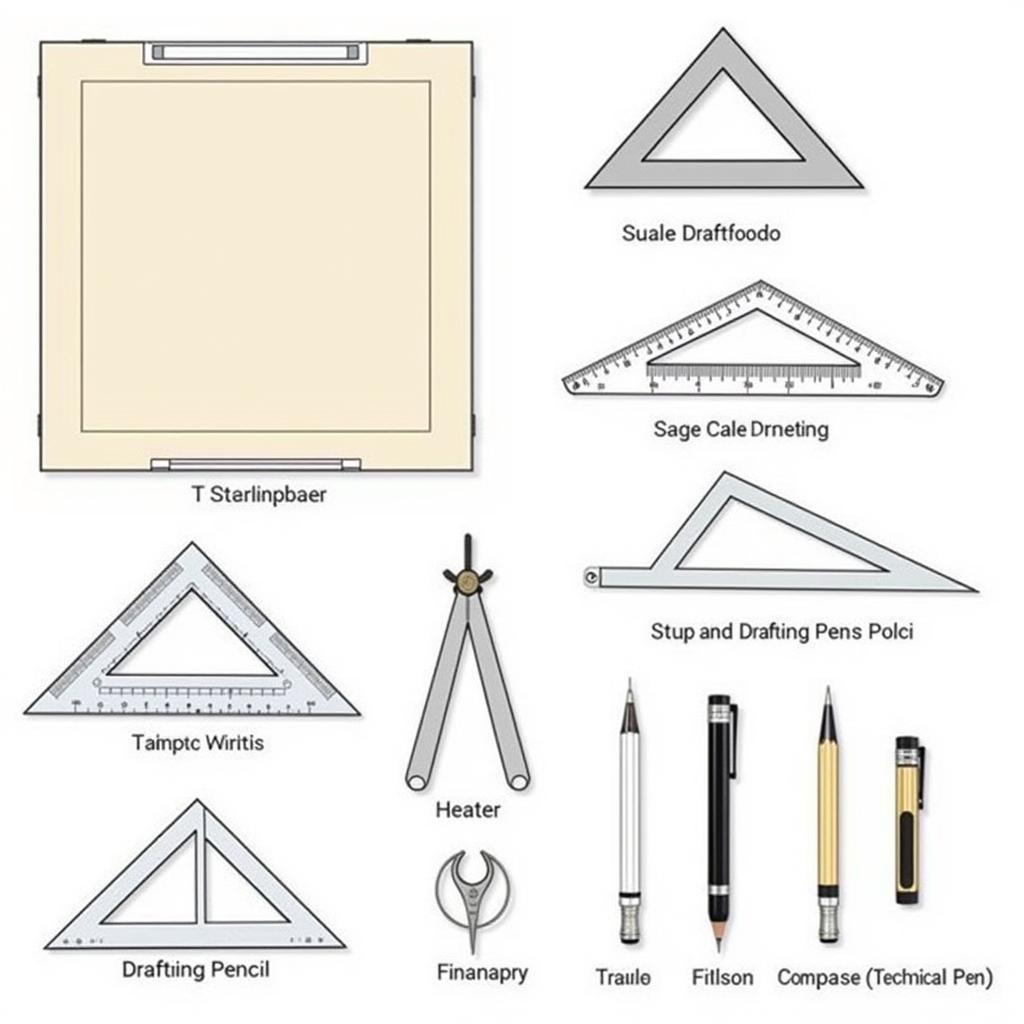Drafting tools and equipments are essential for creating precise technical drawings, whether you’re designing a skyscraper or a small mechanical part. Understanding their uses and proper care ensures accuracy, longevity, and professional results. This comprehensive guide will delve into the world of drafting tools and equipments, covering everything from their various applications to maintenance best practices.
Essential Drafting Tools and Their Uses
Drafting involves a range of specialized tools, each serving a specific purpose. Let’s explore some of the most common ones:
Drawing Board and T-Square
The drawing board provides a stable, flat surface essential for accurate drawing. The T-square, sliding along the board’s edge, ensures perfectly horizontal lines and serves as a base for other tools.
Triangles and Scales
Triangles are used to draw angled lines, commonly 30°, 45°, and 60°. Scales, with their graduated markings, allow for accurate measurements and scaled drawings. Different types of scales exist for various applications.
Compasses and Dividers
Compasses are used for drawing circles and arcs, while dividers are primarily for measuring and transferring distances. Both tools require careful handling to maintain their precision.
Drafting Pencils and Technical Pens
Drafting pencils, with their varying lead grades, offer control over line weight and darkness. Technical pens, on the other hand, provide consistent line widths ideal for inking drawings.
 Essential Drafting Tools Set
Essential Drafting Tools Set
French Curves and Templates
French curves are used to create smooth, irregular curves, while templates provide pre-defined shapes for common elements, saving time and ensuring consistency.
Erasers and Drafting Brushes
Erasers are crucial for correcting mistakes, with different types suited for various pencil and ink types. Drafting brushes help keep the drawing surface clean and free of debris.
Maintaining Your Drafting Tools and Equipments
Proper care and maintenance are vital for extending the lifespan of your drafting tools and equipments and preserving their accuracy.
Cleaning and Storage
Regular cleaning is essential. Use a soft cloth to remove dust and debris from the drawing board, T-square, and triangles. Clean scales and compasses with a mild solvent to remove any ink or pencil residue. Store your tools in a dry, clean environment to prevent rust and damage.
Protecting Your Investment
Always handle your tools with care. Avoid dropping them or subjecting them to excessive force. When not in use, store them in a protective case or drawer to prevent accidental damage.
Sharpening and Refilling
Keep your drafting pencils sharp for precise lines. Use a quality pencil sharpener to avoid damaging the lead. Regularly refill technical pens with the correct type of ink to ensure consistent performance.
 Maintaining Drafting Tools
Maintaining Drafting Tools
Common Drafting Tool Issues and Solutions
Occasionally, you might encounter issues with your drafting tools. Here are some common problems and how to address them:
- Loose compass joints: Tighten the joint carefully using the appropriate tool.
- Dried-out technical pens: Soak the pen tip in warm water or use a pen cleaner.
- Worn-out scale markings: Consider replacing the scale if the markings are significantly faded or damaged.
Why Proper Care Matters
Taking care of your drafting tools is not just about preserving their physical condition; it’s about maintaining accuracy and ensuring professional-quality drawings. Accurate tools lead to precise measurements and clean lines, reflecting professionalism and attention to detail.
“Investing in quality drafting tools is essential,” says renowned architect and drafting expert, David Miller. “But equally important is understanding how to maintain them. Proper care ensures their longevity and accuracy, ultimately contributing to the success of your projects.”
 Precise Technical Drawing Created with Well-Maintained Tools
Precise Technical Drawing Created with Well-Maintained Tools
Conclusion
Understanding the Uses And Care Of Drafting Tools And Equipments is crucial for anyone involved in technical drawing. By following these guidelines, you can maximize the lifespan and accuracy of your tools, resulting in high-quality drawings and a more efficient workflow. Proper maintenance of drafting tools and equipments is a small investment that yields significant returns in terms of accuracy, longevity, and professional results.
FAQs
- What is the best way to clean a drawing board?
- How do I sharpen a drafting pencil correctly?
- What type of ink should I use for my technical pens?
- How do I fix a loose joint on my compass?
- Where should I store my drafting tools when not in use?
- What are the different types of scales used in drafting?
- How often should I clean my drafting tools?
Need assistance with car diagnostics or drafting tools? Contact us via WhatsApp: +1(641)206-8880, Email: [email protected] or visit us at 910 Cedar Lane, Chicago, IL 60605, USA. Our 24/7 customer support team is ready to help.

Leave a Reply